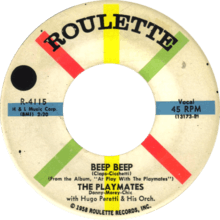Beep Beep (song)
"Beep Beep" is a novelty song by The Playmates, released in 1958 by Roulette Records (catalog number 4115) as the B-side to "Your Love".[1]
| "Beep Beep" | ||||
|---|---|---|---|---|
 One of side-A labels of original 1958 US single | ||||
| Single by The Playmates | ||||
| A-side | "Your Love" | |||
| Released | 1958 | |||
| Genre | Novelty | |||
| Label | Roulette | |||
| Songwriter(s) |
| |||
| The Playmates[1] singles chronology | ||||
| ||||
Production
"Beep Beep" was written by C. Cicchetti and D. Claps.[2]
The song is built around accelerando: the tempo of the song gradually increases commensurate with the increasing speed of the drivers.[3] In his book The Guide to United States Popular Culture, Ray B. Browne lists "Beep Beep" as an example of "motoring music […] in the chase mode".[4] It is a tortoise-and-the-hare story, substituting the drivers of two unequal cars: a Nash Rambler and Cadillac, respectively.[1]
Because of a directive by the BBC at the time that songs did not include brand names in their lyrics, a UK re-recorded version of "Beep Beep" was recorded for the European market replacing the Cadillac and Nash Rambler with the generic terms limousine and bubble car.[5]
Reception
"Beep Beep" began charting with Billboard on November 3, 1958; it charted for 15 weeks, peaking at number four.[6] After the single sold one million copies (the Playmates' only), it was awarded a gold disc by the Recording Industry Association of America.[2] At the height of the song's popularity, The Playmates appeared on the December 3, 1958 episode of The Milton Berle Show.[7][8]
In December 1958, Time credited the popularity "Beep Beep" with helping Nash Motors break records. In November 1958, the company doubled its previous year's production record with 26,782 cars; Ramblers accounted for 9.2% of October 1958's automobile sales in the United States; and though "total U.S. exports slid 16% in 1958, Rambler's climbed 10.3%."[9] The "Beep Beep" song was also popular with the workers building Ramblers on AMC's assembly lines in Kenosha, Wisconsin.[10]
In 1994, a "near-mint commercial copy" of the single was valued at US$8 (equivalent to $13.8 in 2019).[6]
References
- Warner, Jay (2006) [1992]. "The 1950s". American Singing Groups: A History from 1940 to Today. Milwaukee: Hal Leonard Corporation. pp. 278–279. ISBN 0-634-09978-7. LCCN 2006922018.
- Murrells, Joseph (1978) [1974]. "1958". The Book of Golden Discs: The Records That Sold a Million. London: Barrie and Jenkins. p. 106. ISBN 0-214-20480-4.
- Pica, Rae (2008). "Elements of Movement". Physical Education for Young Children: Movement ABCs for the Little Ones. Champaign, Illinois: Human Kinetics. p. 38. ISBN 978-0-7360-7149-9.
- Browne, Ray B.; Browne, Pat (2001). "A". The Guide to United States Popular Culture. Madison, Wisconsin: University of Wisconsin Press. p. 52. ISBN 0-87972-821-3.
- Nielsen Business Media, Inc. (December 1, 1958). Billboard. Nielsen Business Media, Inc. p. 5. ISSN 0006-2510.
- Whitburn, Joel (1994). "Artist Section". Joel Whitburn's Top Pop Singles 1955–1993 (seventh ed.). Menomonee Falls, Wisconsin: Record Research. p. 465. ISBN 0-89820-104-7.
- Rolontz, Bob (December 1, 1958). "Music as Written". Billboard. 70 (48): 7. Retrieved March 1, 2015.
- "Milton Berle and the Texaco Star Theatre". Thomas Film Classics. Retrieved March 1, 2015.
- Alexander, Roy; Fuerbringer, Otto, eds. (December 8, 1958). "Rambler in High Gear". Time. Vol. LXXII no. 23. James A. Linen. pp. 95–96. ISSN 0040-781X. OCLC 1311479.
- Giles, Diane (May 21, 2013). "Little Nash Rambler". That's Entertainment. Kenosha News. Retrieved August 29, 2019.
External links
- "Beep Beep" at AllMusic
- "Beep Beep" at Discogs (list of releases)